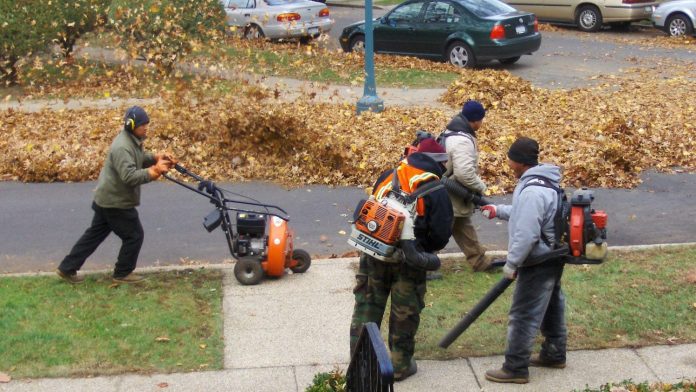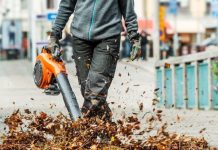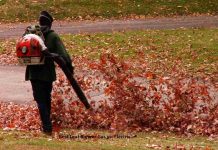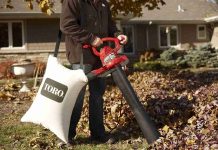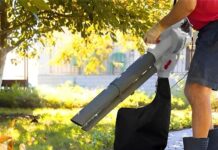California recently made a groundbreaking decision to ban leaf blowers, and we’re here to uncover the reasons behind this bold move.
In a state known for its pristine beaches and stunning landscapes, prohibiting these noisy garden tools has sparked curiosity and raised eyebrows.
As we embark on this exploration, we’ll delve into the environmental concerns, the impact on public health, and the potential alternatives that led to this momentous ban.
Prepare to discover the driving forces behind California’s decision and gain insights into the future of landscaping practices.
Environmental Impact
Leaf blowers have been found to have several negative environmental impacts. Firstly, they contribute to air pollution.
The engines of leaf blowers emit pollutants such as carbon monoxide, nitrogen oxide, and volatile organic compounds into the air. These pollutants harm the atmosphere, contribute to climate change, and pose a health risk to humans and wildlife. Moreover, leaf blowers disturb and disperse dust particles and other delicate particulate matter, further exacerbating air pollution.
Furthermore, the use of leaf blowers also contributes to noise pollution. The high-powered engines produce loud and persistent noise, causing a disturbance in residential areas and disrupting the peace that people value.
This noise pollution affects the quality of life for those living nearby and also impacts wildlife, who rely on a peaceful habitat for survival. Animals and birds, especially those nesting near urban areas, can be severely stressed and endangered by the constant noise generated by leaf blowers.
Another significant impact of leaf blowers is the disruption of wildlife. The loud noises and disturbances caused by leaf blowers can disrupt the natural behavior patterns of animals and birds.
Nesting birds can be scared away, leading to the abandonment of their nests and potentially endangering their eggs or chicks. Similarly, animals relying on undisturbed habitats may be forced to relocate, disrupting their natural ecosystems. This disruption can have far-reaching ecological consequences and result in imbalances in the local wildlife populations.
The impact of leaf blowers extends beyond air pollution and noise disturbance; it also affects vegetation. Leaf blowers generate potent gusts of air, often blowing away leaves, pollen, and seeds from plants with great force.
This removes the protective layer that fallen leaves provide for the soil and disperses pollen and seeds, which are crucial for plant reproduction. Consequently, using leaf blowers can disrupt vegetation’s growth and reproduction cycles, affecting the overall health and biodiversity of ecosystems.
Public Health Concerns
The use of leaf blowers has significant public health concerns. One of the primary issues is the impact on respiratory health. The pollutants emitted by leaf blower engines, such as carbon monoxide and nitrogen oxide, can worsen respiratory conditions such as asthma and bronchitis.
They can also irritate the respiratory system, leading to coughing, wheezing, and shortness of breath. This is particularly problematic for vulnerable populations, including children, older people, and those with pre-existing respiratory conditions, who are more susceptible to the harmful effects of air pollution.
Furthermore, leaf blowers can trigger allergies in individuals sensitive to pollen and other allergens.
As leaf blowers propel air, they also blow around allergenic particles, such as pollen, mold spores, and dust mites, exacerbating allergy symptoms. This can lead to increased sneezing, runny nose, itchy eyes, and respiratory distress, making using leaf blowers a significant health concern for allergy sufferers.
Additionally, using leaf blowers contributes to increased dust and debris in the surrounding environment. The powerful airflow generated by leaf blowers stirs up dust, dirt, and debris from the ground, causing it to become airborne.
This can result in elevated levels of dust particles and other delicate matter in the air, which can have adverse health effects when inhaled. Prolonged exposure to these particles can lead to respiratory irritation, coughing, and long-term lung damage. It is particularly concerning for areas with high foot traffic, such as parks or schools, where the concentration of dust and debris can be significant.
Moreover, the loud noise generated by leaf blowers can also cause hearing damage. Prolonged exposure to high noise levels can lead to hearing loss or impairment and tinnitus (ringing in the ears).
This poses a risk not only to the operators of leaf blowers but also to bystanders, including children and pets, who may be near the equipment. Therefore, the public health concerns associated with leaf blower usage are substantial and warrant careful consideration.
Community Disturbance
Leaf blowers have become a source of disturbance within communities, leading to various adverse effects on the quality of life for individuals living nearby. One of the main concerns voiced by residents is the noise generated by leaf blowers.
The powerful engines produce a continuous and often deafening noise, disrupting the peace and tranquility of neighborhoods. The constant noise can be exceptionally bothersome for those working or studying from home and individuals with medical conditions that require quiet and restful environments.
The disturbance caused by leaf blowers also leads to increased noise complaints from residents. These complaints often arise due to the early morning or late evening operation of leaf blowers, disturbing sleep and creating a sense of inconvenience. The frequency and persistence of the noise can be frustrating for individuals in the community, leading to strained relationships among neighbors and a diminished sense of community spirit.
Furthermore, the noise and disturbance caused by leaf blowers infringe upon the desired peace that many seek in their outdoor spaces. Gardens, parks, and other communal outdoor areas should provide a sanctuary for relaxation and recreation. However, leaf blowers disrupt these environments, depriving individuals of the chance to enjoy a peaceful and serene atmosphere.
The adverse effects on the quality of life within communities extend beyond noise disturbance. The constant use of leaf blowers can create a sense of unease and tension among residents, who may associate the noise and disruption with an overall decline in the livability of their neighborhood. This can have psychological implications, as individuals may feel frustrated, stressed, or even powerless due to the ongoing disturbance caused by leaf blowers. Ultimately, the community disturbance caused by leaf blower usage harms people’s mental well-being and overall quality of life.
Inefficiency and Ineffectiveness
Despite their widespread usage, leaf blowers have shown inherent inefficiencies and ineffectiveness in several aspects of their functionality. One significant limitation is their limited sweep capacity. While leaf blowers are designed to move leaves, debris, and other loose materials, they often struggle to effectively clear large areas or handle an extensive accumulation of leaves. This limitation results in the repetitive back-and-forth motion of operators, prolonging the time and effort required to complete tasks.
Moreover, leaf blowers tend to blow dust and debris onto neighboring properties. The high air velocity generated by leaf blowers may succeed in removing leaves from one area. Still, the gusts of wind created by the equipment propel the debris onto adjacent properties or into nearby streets. This creates additional clean-up tasks for neighboring residents and redistributes the dust and allergenic particles into new areas, worsening air quality concerns.
Furthermore, leaf blowers have proven to be ineffective when it comes to handling wet leaves. Wet leaves are more significant and heavier and tend to clump together, making it challenging for leaf blowers to dislodge them effectively. This limitation forces operators to spend more time and effort attempting to clear wet leaves, often resorting to manual methods such as raking or sweeping. As a result, the inefficiency and ineffectiveness of leaf blowers become evident, highlighting the need for alternative approaches to leaf and debris management.
Dangers and Safety Concerns
Using leaf blowers poses various dangers and safety concerns for operators and bystanders. One of the most apparent risks is the potential for flying debris. The strong gusts of air produced by leaf blowers can propel small rocks, twigs, and other loose objects at high speeds. This poses a risk of injury to the operator and anyone to the equipment. Bystanders, including pedestrians, cyclists, and children, are particularly vulnerable to being hit by these flying projectiles, potentially causing serious harm.
Furthermore, equipment malfunctions can pose a significant safety hazard. Leaf blowers are complex machines with numerous moving parts, and accidents can occur when these parts fail or become damaged. Malfunctions, such as dislodged or broken components, can result in flying debris, sudden changes in air direction, or even the machine itself becoming uncontrollable. These malfunctions not only put the operator at risk of injury but also threaten bystanders who may be nearby.
In addition, leaf blower operators themselves face the risk of injuries. The repetitive motion required to operate leaf blowers for extended periods can strain the muscles and joints, leading to musculoskeletal disorders. Back pain, shoulder injuries, and carpal tunnel syndrome are common ailments experienced by operators. Furthermore, constant exposure to high noise levels can result in hearing damage over time, accentuating the risks to operator health and safety.
Considering the potential dangers and safety concerns associated with leaf blower usage, it is essential to prioritize the well-being of both operators and bystanders. Implementing safety measures, providing proper training, and exploring alternative methods are critical steps toward mitigating these risks and ensuring a safer environment for everyone involved.
Legislation and Regulation
Recognizing the environmental, health, and community concerns surrounding leaf blowers, legislative measures, and regulations have been put in place to address these issues. The California Air Resources Board (CARB) has implemented regulations to reduce emissions from small off-road engines, including those found in leaf blowers. These regulations aim to promote cleaner and more environmentally friendly alternatives to reduce air pollution and improve air quality.
Additionally, various local cities and counties have implemented bans on leaf blower usage or imposed restrictions on their operation. These bans and restrictions seek to address the noise pollution and community disturbance caused by leaf blowers. By limiting their usage or setting specific noise level limits, local authorities aim to protect their residents’ well-being and quality of life.
Alongside noise restrictions, permit requirements have been introduced in some jurisdictions, ensuring that the usage of leaf blowers is regulated and monitored. These permits often involve criteria such as limited operating hours, compliance with noise standards, and regular maintenance to reduce emissions. The permit requirements provide a means to balance the need for landscaping and maintenance services with the environmental and community concerns associated with leaf blower usage.
Overall, the legislation and regulations surrounding leaf blowers reflect the recognition of the environmental and public health impacts caused by their usage. Through these measures, steps are being taken to address community concerns and implement safeguards to protect the environment, public health, and quality of life.
Alternatives to Leaf Blowers
As the negative impacts of leaf blowers become more evident, various alternatives have emerged as more sustainable and environmentally friendly options. These alternatives prioritize the reduction of noise pollution, air pollution, and community disturbance while still achieving effective leaf and debris management. Some of the most notable alternatives include manual raking, brooms and push brooms, mulching mowers, and electric or battery-powered blowers.
Manual raking is a traditional and labor-intensive method that involves using a rake to gather leaves into piles for collection. While this method may be time-consuming and physically demanding, it offers the advantage of being free of noise pollution, air pollution, and the risks associated with flying debris. Manual raking also allows for a closer connection to the environment, enabling individuals to appreciate the seasonal changes and actively engage with the process of yard maintenance.
Brooms and push brooms are another viable alternative to leaf blowers. While they may require more physical effort than other methods, brooms and push brooms provide a quiet and efficient means of clearing leaves and debris. These tools have the added benefit of being cost-effective and requiring no additional equipment or power sources.
Mulching mowers offer a unique solution to leaf management by simultaneously cutting and mulching leaves into smaller pieces that can act as a natural fertilizer for lawns and gardens. By mulching leaves directly into the soil, this method eliminates the need for collection and disposal and nourishes the surrounding vegetation. Mulching mowers help maintain soil health and reduce waste, making them an eco-friendly alternative to leaf blowers.
Electric or battery-powered blowers offer a more sustainable option than gas-powered leaf blowers. By utilizing electricity or rechargeable batteries, these blowers eliminate emissions, reduce noise levels, and lower the overall environmental impact. Electric or battery-powered blowers are particularly suitable for smaller-scale operations and residential areas, where these models’ limited power and run-time are less of a concern.
The availability of these alternatives demonstrates that effective leaf and debris management can be achieved without the negative impacts of leaf blowers. By adopting these alternative methods, individuals can actively contribute to creating a healthier, more sustainable environment.
Role of the Landscaping Industry
The bans and restrictions on leaf blowers have presented significant challenges for the landscaping industry. As professionals in the field, landscapers heavily rely on leaf blowers to efficiently manage leaves and debris for their clients. The implementation of bans and restrictions has required landscapers to adapt their practices and explore new methods that align with the sustainable goals of the communities they serve.
Adapting to the bans has meant revisiting traditional manual methods, such as raking and using brooms. Landscapers have had to allocate more time and workforce to complete the same tasks, adjusting their service offerings accordingly. In addition, the transition to alternative equipment, such as mulching mowers or electric blowers, has required investment in new tools and retraining employees. This adaptability highlights the commitment of the landscaping industry to finding solutions that are both environmentally friendly and meet the changing needs of their clients.
Challenges faced by professionals in the landscaping industry extend beyond the initial investment in new equipment. Training their workforce to utilize these alternative methods effectively and efficiently is crucial for successful adoption. The transition involves reevaluating workflows, educating employees on best practices, and ensuring compliance with local regulations. These challenges require landscaping companies to proactively update their practices and provide ongoing training to their staff.
Despite the challenges, many professionals in the landscaping industry have embraced the opportunity to transition to more sustainable practices. They recognize the importance of reducing the environmental impact of their work and are committed to providing services that align with the goals and values of their communities. This adaptability and commitment exemplify the role of the landscaping industry in driving positive change and leading the way toward a more sustainable future.
Public Opinion and Support
The bans and restrictions on leaf blowers have garnered significant public support and generated increased awareness of the environmental and health impacts associated with their usage. Environmental groups form a strong backbone of support, advocating for the reduction or elimination of leaf blowers due to their adverse effects. These groups, often composed of concerned citizens, scientists, and activists, understand the importance of preserving air quality, reducing noise pollution, and protecting ecosystems. Their support emphasizes the need for sustainable alternatives and has helped amplify the public discourse surrounding leaf blowers.
Communities have also taken the initiative through local initiatives and petitions to express their concerns and advocate for change. Residents increasingly realize the impact of leaf blower usage in their neighborhoods and are mobilizing to voice their opinions. Petitions calling for restrictions or bans on leaf blowers have gained traction, emphasizing community-driven efforts to protect their living spaces’ health, well-being, and tranquility.
Support for reducing or eliminating leaf blowers extends beyond environmental groups and community initiatives; it also includes residential and commercial support. Homeowners and businesses recognize the importance of aligning their practices with sustainable goals and actively seek landscaping companies that prioritize eco-friendly methods. This growing demand for sustainable alternatives indicates a shift in public opinion towards embracing practices that reduce environmental impact and promote health and well-being.
Public opinion and support for reducing leaf blower usage are crucial drivers for change. Increased awareness, support from environmental groups, and community initiatives demonstrate a collective desire to prioritize environmental sustainability and quality of life.
Conclusion and Future Outlook
California’s ban on leaf blowers highlights the growing understanding of their adverse environmental, health, and community impacts. The comprehensive examination of environmental impacts, public health concerns, community disturbance, inefficiency, safety concerns, legislation, and alternatives underscores the need for sustainable leaf and debris management practices.
By recognizing the harm caused by leaf blowers and implementing bans and restrictions, California promotes sustainable landscaping practices. Adopting alternative methods such as manual raking, using and pushing brooms, mulching mowers, and electric or battery-powered blowers signifies a shift towards eco-friendly solutions.
The role of the landscaping industry is pivotal in successfully navigating this transition. By adapting to the bans, investing in alternative equipment, and retraining their workforce, professionals in the industry demonstrate their commitment to sustainable practices.
Public opinion and support play a crucial role in driving change. The support from environmental groups, community initiatives, and residential and commercial sectors reflects a growing recognition of the importance of environmental sustainability and quality of life.
The future outlook is positive, with the bans and restrictions leading to significant environmental and health benefits. Reductions in air and noise pollution, preservation of wildlife habitats, and improved quality of life are among the positive outcomes. Notably, the ban’s success in California may encourage other regions to consider similar measures, leading to potential expansion of bans and greater adoption of sustainable alternatives nationwide.
In conclusion, California’s ban on leaf blowers is a significant step towards a healthier, more sustainable future. The recognition of their negative impacts, combined with implementing bans and adopting eco-friendly alternatives, sets the stage for positive change. By prioritizing environmental sustainability, public health, and community well-being, the ban on leaf blowers paves the way for a greener and more harmonious existence.

